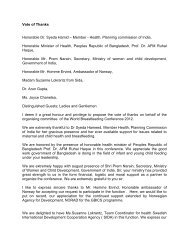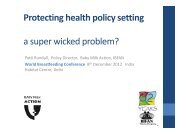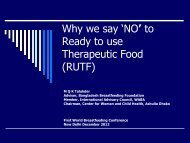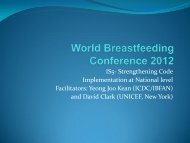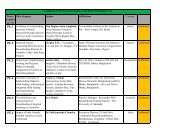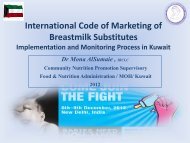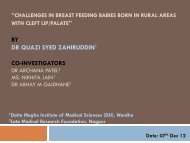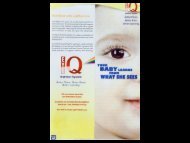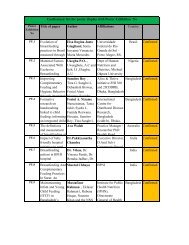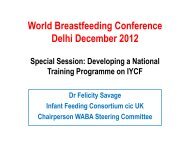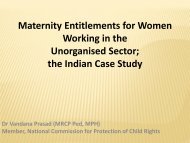Early and exclusive breastfeeding in Vietnam â determinants ...
Early and exclusive breastfeeding in Vietnam â determinants ...
Early and exclusive breastfeeding in Vietnam â determinants ...
Create successful ePaper yourself
Turn your PDF publications into a flip-book with our unique Google optimized e-Paper software.
<strong>Early</strong> <strong>and</strong> Exclusive<br />
Breastfeed<strong>in</strong>g <strong>in</strong> <strong>Vietnam</strong><br />
Determ<strong>in</strong>ants & Recommendations<br />
Nguyen Thanh Tuan 1 , MD, PhD<br />
Nguyen Hong Phuong 2 , MD, PhD<br />
Nemat Hajeebhoy 1 , MSW, MHS<br />
World Breastfeed<strong>in</strong>g Conference<br />
New Delhi December 6-9, 2012
Why Breastfeed<strong>in</strong>g?<br />
• <strong>Vietnam</strong> is a country <strong>in</strong> Southeast<br />
Asia, population of ~88 millions, <strong>and</strong><br />
7.2 millions children < 5 years old<br />
• About 2 millions (29%) children<br />
under five <strong>in</strong> <strong>Vietnam</strong> is stunted<br />
• National Nutrition Strategy aims to<br />
reduce this rate to 26% by 2015 <strong>and</strong><br />
23% by 2020<br />
• <strong>Early</strong> <strong>and</strong> <strong>exclusive</strong> <strong>breastfeed<strong>in</strong>g</strong> is<br />
critical for child nutrition <strong>and</strong> health
Objectives<br />
Gaps: In <strong>Vietnam</strong>, few studies have explored current<br />
status <strong>and</strong> determ<strong>in</strong>ants of <strong>breastfeed<strong>in</strong>g</strong> practices at<br />
the national level<br />
Objective: to identify critical determ<strong>in</strong>ants of optimal<br />
<strong>breastfeed<strong>in</strong>g</strong> practices, with focus on early <strong>and</strong><br />
<strong>exclusive</strong> <strong>breastfeed<strong>in</strong>g</strong>
Methods<br />
• Respondents from urban <strong>and</strong><br />
rural areas <strong>in</strong> 11 prov<strong>in</strong>ces <strong>and</strong> 4<br />
ecological regions <strong>in</strong> <strong>Vietnam</strong><br />
• Face-to-face <strong>in</strong>terview 6068<br />
mothers with children
Feed<strong>in</strong>g <strong>in</strong> the First Three Days After Birth<br />
80<br />
70<br />
69.7<br />
<strong>Early</strong> Initiation of Breastfeed<strong>in</strong>g<br />
(49.3%; n=6068)<br />
80<br />
70<br />
73.3<br />
Prelacteal Feed<strong>in</strong>g<br />
(n=6068)<br />
60<br />
56.4<br />
60<br />
53.5<br />
50<br />
44.1<br />
50<br />
44.1<br />
40<br />
40<br />
30<br />
30<br />
20<br />
10<br />
0<br />
Vag<strong>in</strong>al<br />
Delivery<br />
At CHC<br />
Overall<br />
10.4<br />
Cesarean<br />
Delivery<br />
Vag<strong>in</strong>al<br />
Delivery<br />
At Hospitals (79%)<br />
20<br />
10<br />
0<br />
14.8<br />
2.8<br />
Any Formula Water Honey Sugar<br />
Solution
Prevalence Ratios (PR, 95%CI)<br />
<strong>Early</strong> Breastfeed<strong>in</strong>g & Challenges (n=6,068)<br />
1<br />
0.87<br />
0.78<br />
0.81<br />
0.75<br />
0.5<br />
0.19<br />
0<br />
Hospital<br />
Delivery<br />
Cesarean<br />
Delivery<br />
Intention of<br />
Feed<strong>in</strong>g<br />
Formula<br />
Perceived<br />
Breastfeed<strong>in</strong>g<br />
Difficulty<br />
Liv<strong>in</strong>g <strong>in</strong><br />
Urban Area
Prevalence Ratios (PR, 95%CI)<br />
<strong>Early</strong> Breastfeed<strong>in</strong>g & Supports (n=6,068)<br />
3<br />
2.83<br />
2.5<br />
2<br />
1.5<br />
1<br />
1.08 1.02 1.11<br />
0.95<br />
0.5<br />
Knew<br />
Benefit<br />
Health<br />
Workers<br />
Family<br />
Members<br />
Health<br />
Workers<br />
Family<br />
Members<br />
Dur<strong>in</strong>g Pregnancy<br />
After Birth
Prevalence Ratios (PR, 95%CI)<br />
Exclusive Breastfeed<strong>in</strong>g & Challenges (n=6,068)<br />
1<br />
0.93 0.94<br />
Exclusive Breastfeed<strong>in</strong>g Rate: 20.2%<br />
0.88<br />
0.5<br />
0.15<br />
0<br />
Perceived<br />
Breastfeed<strong>in</strong>g<br />
Difficulty<br />
Seen Formula Ads<br />
Daily<br />
Not seen<br />
Breastfeed<strong>in</strong>g Ads<br />
Liv<strong>in</strong>g <strong>in</strong><br />
Urban Area
Prevalence Ratios (PR, 95%CI)<br />
Exclusive Breastfeed<strong>in</strong>g & Supports (n=6,068)<br />
3<br />
2.5<br />
2<br />
1.89<br />
1.5<br />
1<br />
1.07<br />
0.95<br />
1.20<br />
0.97<br />
0.5<br />
Knew<br />
Benefit<br />
Health<br />
Workers<br />
Family<br />
Members<br />
Health<br />
Workers<br />
Family<br />
Members<br />
Dur<strong>in</strong>g Pregnancy<br />
After Birth
Keys F<strong>in</strong>d<strong>in</strong>gs<br />
• Breastfeed<strong>in</strong>g Practices:<br />
– Ever breastfed: 99.5%<br />
– <strong>Early</strong> <strong>breastfeed<strong>in</strong>g</strong>: 49.3%<br />
– Prelacteal feed<strong>in</strong>g: 73.3%<br />
– Exclusive freastfeed<strong>in</strong>g under 6 months: 20.2%<br />
• <strong>Early</strong> Breastfeed<strong>in</strong>g:<br />
– Negatively associated with cesarean delivery, hospital delivery,<br />
<strong>in</strong>tention of feed<strong>in</strong>g formula, perceived <strong>breastfeed<strong>in</strong>g</strong> difficulties,<br />
<strong>and</strong> liv<strong>in</strong>g <strong>in</strong> urban areas.<br />
– Positively associated with knowledge <strong>and</strong> be<strong>in</strong>g support by a<br />
health worker dur<strong>in</strong>g pregnancy <strong>and</strong> after birth<br />
• Exclusive Breastfeed<strong>in</strong>g:<br />
– Negatively associated with exposure to formula ads, nonexposure<br />
to <strong>breastfeed<strong>in</strong>g</strong> <strong>in</strong>formation, perceived <strong>breastfeed<strong>in</strong>g</strong><br />
difficulties, <strong>and</strong> liv<strong>in</strong>g <strong>in</strong> urban areas.<br />
– Positively associated with knowledge <strong>and</strong> be<strong>in</strong>g support by a<br />
health worker after birth
Conclusions <strong>and</strong> Recomendations<br />
In conclusion, early <strong>and</strong> <strong>exclusive</strong> <strong>breastfeed<strong>in</strong>g</strong> rates <strong>in</strong><br />
<strong>Vietnam</strong> are low, <strong>and</strong> can be improved with through the<br />
follow<strong>in</strong>g:<br />
• Reduc<strong>in</strong>g unessessary cesarean delivery <strong>and</strong> improv<strong>in</strong>g<br />
hospital design<br />
• Build<strong>in</strong>g health worker capacity to provide per<strong>in</strong>atal<br />
counsel<strong>in</strong>g & support<br />
• Ensur<strong>in</strong>g greater exposure to <strong>breastfeed<strong>in</strong>g</strong> messages<br />
while simultaneously strengthen<strong>in</strong>g regulations on the<br />
market<strong>in</strong>g of breastmilk substitutes
“While <strong>breastfeed<strong>in</strong>g</strong><br />
may not seem the<br />
right choice for every<br />
parent, it is the best<br />
choice for every baby”<br />
Amy Spangler<br />
Thank You



